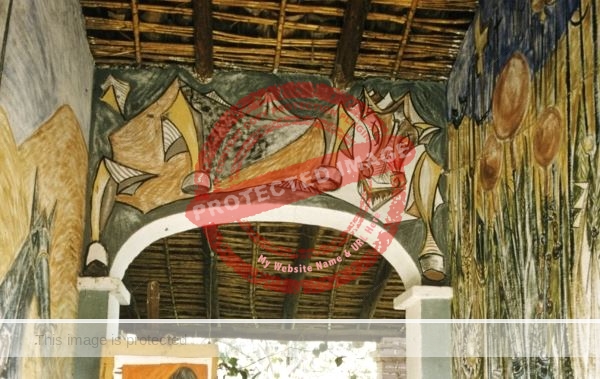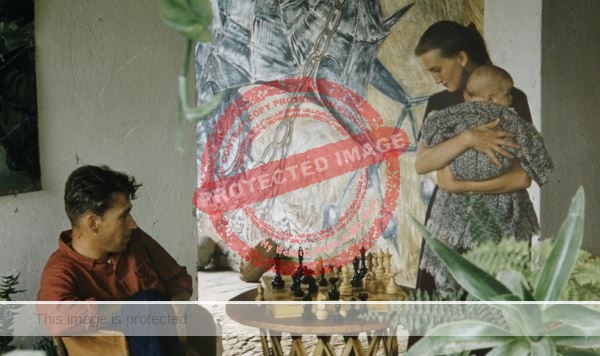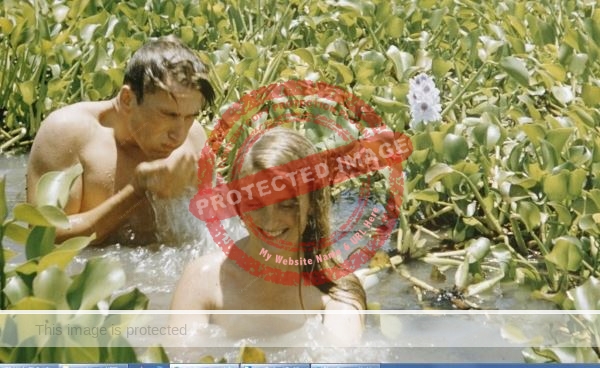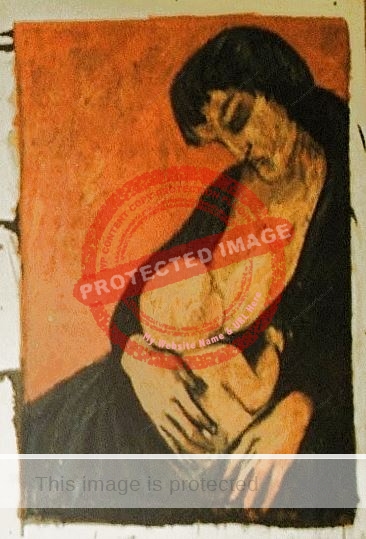American couple Jim and Gloria Marthai took early retirement and moved to Ajijic in 1969. After 5 years there, they opted out of its bright lights in favor of the small village of San Pedro Tesistán on the south side of the lake. Very very few foreign residents have chosen to live in San Pedro; the Marthais lived there 15 years, enjoying the simple life and rural surroundings. Gloria, a keen rider, made regular forays on her horse to nearby villages and to the higher elevations behind their home, including the summit of the volcanic peak Cerro García, the highest point around the lake.
The Marthais’ lifestyle and willingness to learn Spanish enabled them to take an active part in village life and they quickly gained friends and became well integrated into their adopted community.
The couple later moved to the Roca Azul subdivision on the outskirts of Jocotepec.
James Louis Marthai (born in New York City on 22 November 1918) had first met Gloria (born in Canton, Ohio, on 7 September 1928) in California, where they both worked for General Dynamics Corporation, and married in Nevada on 28 June 1958.
The Marthais spent the first six years of their early retirement cruising the Bahamas and the U.S. east coast aboard their private 43-foot classic Elko cruiser.
After returning to live on land in Mexico in 1969, Jim Marthai developed his skills in poetry, sculpture, ivory carving and jewelry design.
He read some of his original poems at a Sunday evening of music and poetry held in 1971 at the home of Aileen Melby, a poet and children’s author, and her husband, Arthur. Jules Rubinstein and Katie Ingram also read poems at that informal soirée.
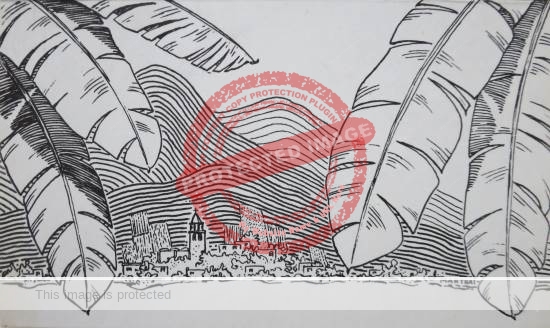
James Marthai. 1977. Drawing used for charity card in aid of Amigos de Salud.
Jim was an accomplished sculptor, carver-especially of miniatures-and jeweler, using raw materials that varied from ebony and bone to walrus tusks and precious metals. He also made one-of-a-kind hunting knives.
Gloria immersed herself in Mexico and her experiences were the basis for a series of stories written for Mexconnect, El Ojo del Lago and the Lake Chapala Review. She contributed several pieces to Aguas Marías: Border Crossers, Boundary Breakers, a compilation of writings by 10 American and Canadian women living at Lake Chapala. Her one-paragraph bio in that book summed up her motivation to write:
“When I came to Mexico in 1969, I entered a time warp. It was the United States 100 years ago, a land of the horse. I was, and still am, intrigued and inspired by this country. I studied Spanish and bought my first horse early on, which led to easy assimilation into rural village life and an endless trail of adventure. How could I not write about it? Besides, I like tequila.”
In addition, she made made artistic shirts, mosaics and unusual decorative mobiles, frequently using bone and recycled materials.
Both Jim and Gloria Marthai had artwork exhibited in a show in October 1976 entitled “Arts and Crafts of Lake Chapala”, held at the ex-Convento del Carmen in Guadalajara and organized by the Jalisco State government. Other Lakeside artists in that show included Antonio Cardenas; Conrado Contreras; Manuel Flores; Gustel Foust; John Frost; Guillermo Gómez Vázquez; Antonio López Vega; Julia Michel [Gail Michel]; Bert Miller; Dionisio Morales; and Georg Rauch.
The following month, Gloria’s “bone mobiles” and Jim’s “crafted jewelry” were on sale at an Art and Craft Bazaar organized in Ajijic by Galería del Lago. Gallery manager Katie Goodridge Ingram, subsequently included Jim’s work in a show she organized for the Jalisco Fine Arts and Tourism departments in Puerto Vallarta. (That show also included works by Jean Caragonne; Conrado Contreras; Daniel de Simone; Gustel Foust; John Frost; Richard Frush; Hubert Harmon; Rocky Karns; Gail Michel; Bob Neathery; David Olaf; John K. Peterson; Georg Rauch; and Sylvia Salmi.)
In 1977, Jim Marthai’s drawing of a village scene (image) was used for the Amigos de Salud charity cards, available in either color or black and white. That same year Marthai illustrated The Before and After Dinner Cookbook, written by two Lakeside residents, Charlotte McNamara and Lenore Howell.
Jim Marthai died in Mexico on 14 March 2005; his wife, Gloria, passed away on 11 November 2011.
In a strange twist of horsehair, Jim Marthai’s legacy still lives on in the small town of Cajititlán, mid-way between Chapala and Guadalajara, where several families make hand-woven belts, sashes and bands for charro hats from long strands of horsehair. It was Marthai who first taught the techniques to a local woman, Consuelo Cervantes, and her son Diego in the early 1980s. She has since taught others. The unusual and ingenious handicrafts are sold at rodeos and charro events.
Acknowledgment
My thanks to Phyllis Rauch for sharing her fond memories of Jim and Gloria Marthai.
Sources
- Colony (Guadalajara) Reporter: 6 Feb 1971; 20 March 1971; 30 Oct 1976, 23; 8 Oct 1977, 18; 18 November 2011.
- El Informador: 25 Oct 1976.
- Charlotte McNamara and Lenore Howell. 1977. The Before and After Dinner Cookbook (illustrations by James L. Marthai). Atheneum.
- Ojo del Lago: November 1987.
- John Pint. 2012. “Mexican artisans of Lake Cajititlan.” MexConnect.com. 18 May 2012. [25 March 2019]
Comments, corrections or additional material related to any of the writers and artists featured in our series of mini-bios are welcome. Please use the comments feature at the bottom of individual posts, or email us.
